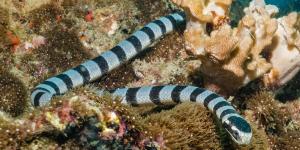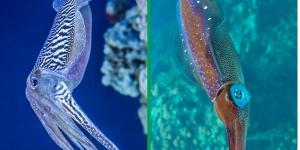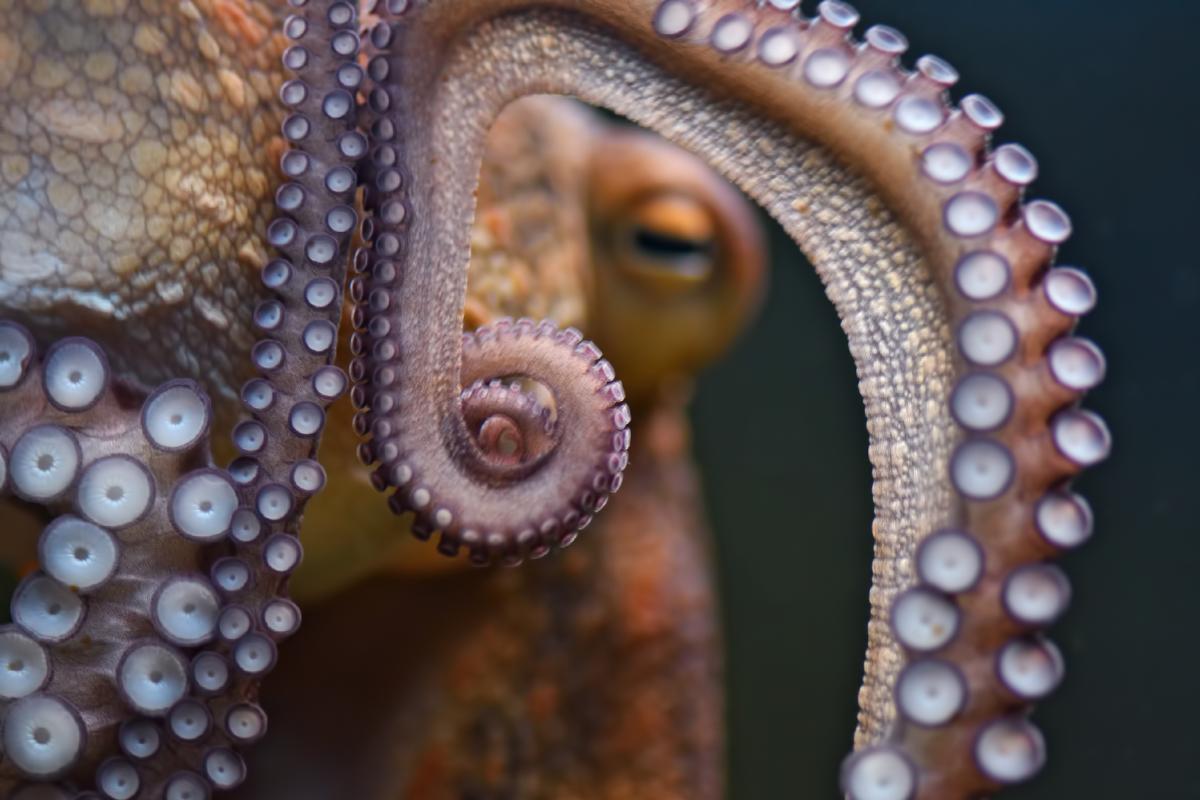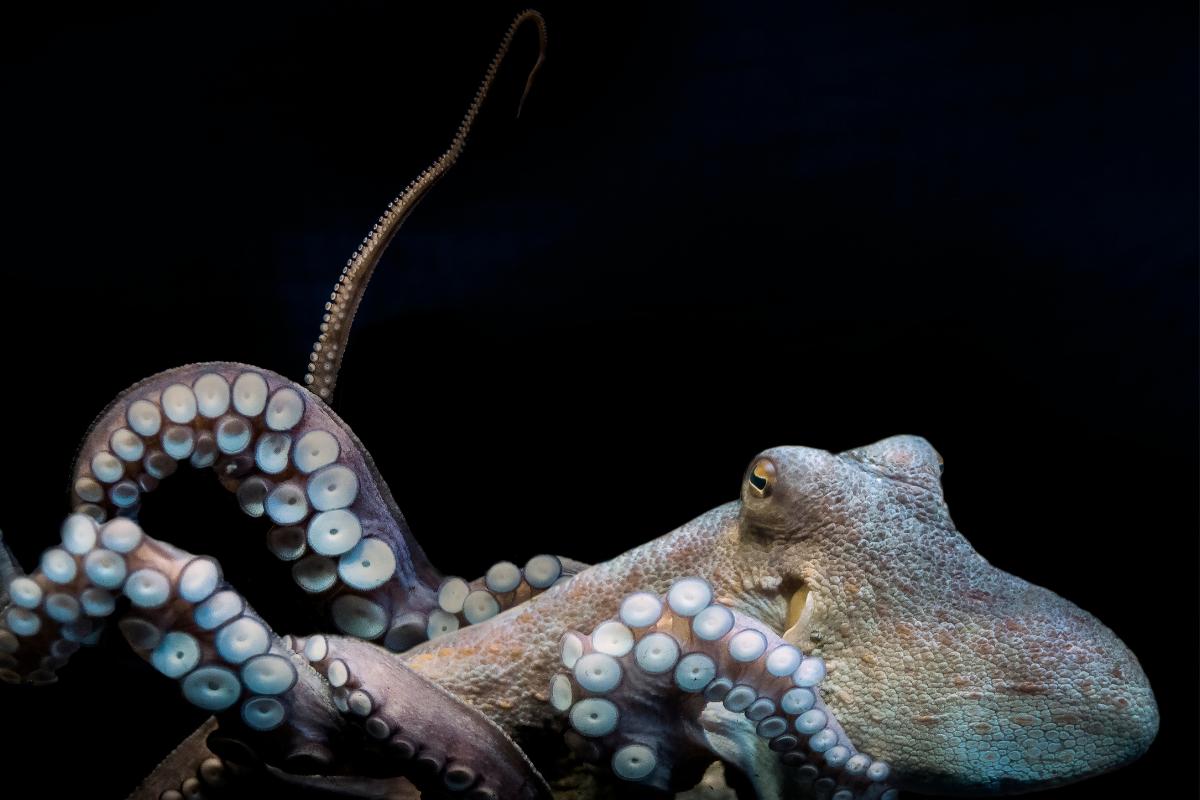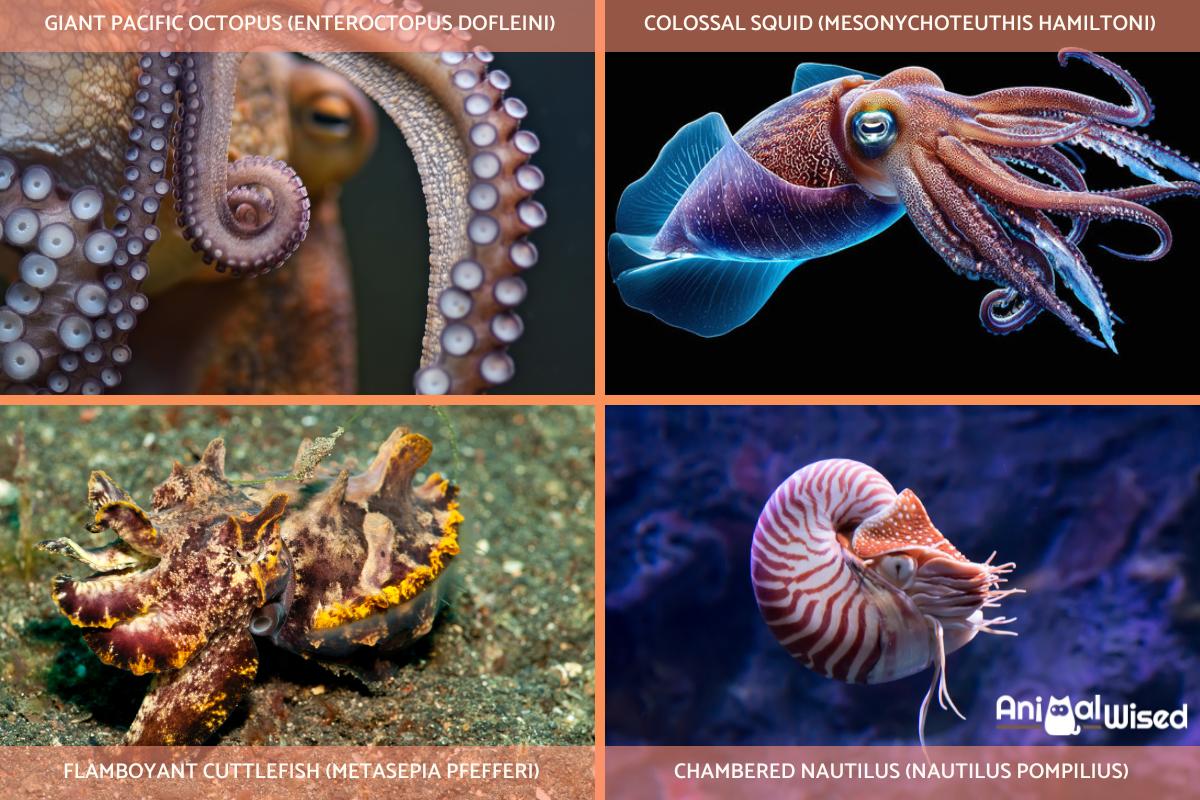What Are Cephalopods? - Examples & Key Features

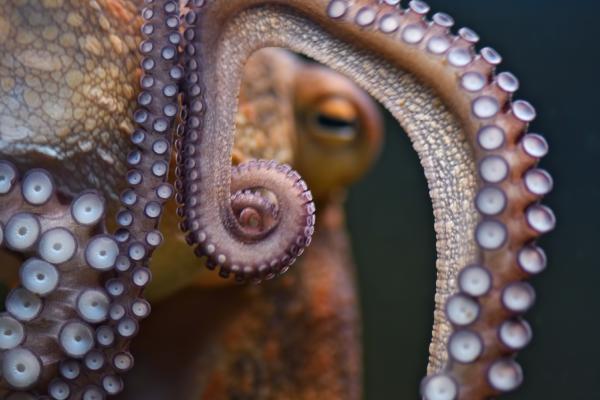
Cephalopods are some of the most fascinating marine animals on Earth, including familiar faces like the octopus, squid, and nautilus. Living in oceans across the globe, they're easy to spot thanks to their prominent head and a set of arms or tentacles circling their mouth. But these creatures are more than just their unique anatomy, they are celebrated for their intelligence and abilities.
The following article by thedailyECO explains what cephalopods are, their unique characteristics, and we also look at some explore some examples.
What are cephalopods?
Cephalopods are marine animals that taxonomically form the class Cephalopoda, which in Greek means "head-foot." This class belongs to the phylum Mollusca, making cephalopods relatives of snails, clams and oysters. .
What makes cephalopods particularly fascinating is how they've evolved differently from most mollusks. While many mollusks rely on protective shells and relatively simple nervous systems, cephalopods developed sophisticated brains, complex eyes with excellent vision, advanced hunting strategies, remarkable problem-solving abilities, and rapid adaptation mechanisms.
Cephalopods first appeared in the fossil record about 500 million years ago during the Late Cambrian period. They represent the most neurologically advanced of all invertebrates and are considered the most intelligent of all non-vertebrate animals.
Based on neuron count, cephalopods can be compared to dogs and some primates, though their nervous system is structured differently. In fact, two-thirds of their neurons extend throughout their arms rather than being concentrated in the brain.
The approximately 800 living species of cephalopods are organized into two main groups:
- Nautiloidea: which is represented today only by nautilus species with external shells.
- Coleoidea: this group includes all other living cephalopods, such as octopuses, squids, and cuttlefish.
Cephalopods are exclusively marine creatures, unlike some of their mollusk relatives, they never successfully adapted to freshwater or terrestrial environments.
Key characteristics of cephalopods
Cephalopods possess many characteristics that help them thrive and make them some of the most incredible creatures in our oceans. Here are a few of their most important traits:
Anatomy:
A cephalopod's body includes two eyes, a mantle, a siphon, and arms or tentacles. Most species have between eight and ten appendages, though members of the Nautilida order can have up to 90.
Evolved shell structure:
Unlike their relatives (snails and bivalves), the shell of most cephalopods has evolved dramatically. In cuttlefish and squids, it has become an internal structure. In octopuses, it has disappeared completely, while in nautilids, the shell remains external and resembles that of a snail.
Specialized appendages:
Cephalopods have arms or tentacles that can extend and retract, primarily helping them capture prey. These flexible appendages are lined with suction cups that provide remarkable gripping power.
Highly developed vision:
Their eye complexity is comparable to human eyes. While the nautilid eye is more basic, with only a pupil, other cephalopods have eyes with iris, pupil, lens, and in some cases, a cornea. Although traditionally believed to be colorblind, new studies suggests they may perceive colors through changes in pupil shape.
Jet propulsion movement:
Most cephalopods move using jet propulsion. This means that their muscles draw water into the body, which is then expelled through the siphon, propelling the animal in the opposite direction. Some octopuses also use their arms to walk along the ocean floor.
Camouflage abilities:
One of the most distinctive features of cephalopods is their ability to camouflage by changing both skin color and texture. Specialized cells called chromatophores contain thousands of pigments and connect to muscle fibers.
These muscles can change the chromatophore's shape, determining which pigments are visible. They can also modify skin texture from completely smooth to covered with spine-like projections.
Ink defense mechanism:
All species except nautiluses and the Cirrina suborder of octopuses produce ink, which they expel to create a dark cloud that confuses predators and facilitates escape. The ink accumulates in specialized sacs located near the gills and is expelled along with jets of water projected through the siphon, helping to spread the ink cloud.
Did you know that an octopus has three hearts, blue blood, and a distributed nervous system unlike any other animal? Explore the internal workings of these cephalopods in our other article.
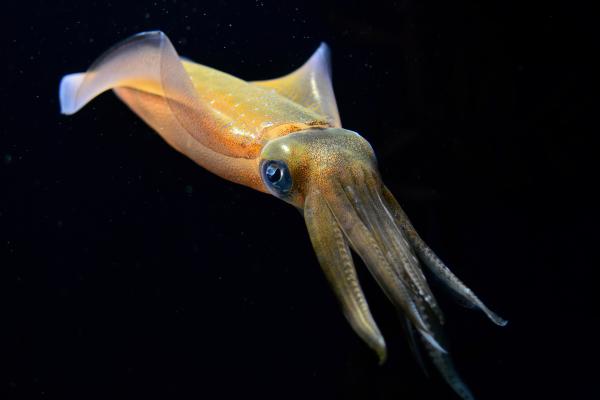
What habitat do cephalopods live in?
Cephalopods have mastered life in nearly every ocean environment on Earth. From warm tropical reefs to frigid polar waters, and from sun-dappled shallows to the crushing darkness of deep-sea trenches, these adaptable creatures have found their niche.
- In coastal shallows, octopuses and cuttlefish rely on their camouflage abilities, changing colors and textures to blend with coral reefs or sandy bottoms.
- Dive deeper to the twilight zone (650-3,300 feet), and you'll find squid species like the firefly squid (Watasenia scintillans) using bioluminescence to communicate in the dimming light.
- Descend further into the perpetual darkness beyond 3,300 feet, and cephalopods become even more specialized. The vampire squid (Vampyroteuthis infernalis) feeds on drifting organic particles in oxygen-poor waters, while glass squids (family Cranchiidae) have evolved near-transparent bodies that disappear in the deep darkness.
- Most impressively, some hardy octopus species have been documented in ocean trenches below 20,000 feet, withstanding pressures that would crush most other creatures.
Geographically, cephalopod diversity peaks in the warm waters of the Indo-Pacific, particularly in the Coral Triangle stretching from Indonesia to the Solomon Islands. This region serves as a hotspot for reef-dwelling octopuses and cuttlefish that have evolved alongside vibrant coral ecosystems.
Within these broader regions, cephalopods have also adapted to specific microhabitats with ingenious solutions. The mimic octopus (Thaumoctopus mimicus) inhabits muddy estuaries in Southeast Asia, where it impersonates dangerous creatures from sea snakes to lionfish. The Humboldt squid (Dosidicus gigas) travels hundreds of feet vertically each day, hunting in deep waters during daylight and rising toward the surface at night. Perhaps most cleverly, the coconut octopus (Amphioctopus marginatus) collects discarded shells and human debris to create portable shelters.
While some cephalopods thrive in the open ocean waters, they share this vast habitat with numerous other creatures. Learn about the diverse animals that spend their lives swimming in the ocean's middle layers.
What do cephalopods eat?
All cephalopods are carnivores, and are equipped with a parrot-like beak that is quite effective at biting and tearing food. Behind this beak is a radula, which is a tongue-like organ with tiny teeth that shreds food before swallowing.
As is to be expected, different cephalopods have different hunting techniques. Some octopuses ambush prey from hiding spots, using their problem-solving intelligence to extract animals from shells. Squid, on the other hand, are active hunters, chasing down prey with their streamlined bodies and snatching them with specialized feeding tentacles that shoot out at remarkable speed. Finally, nautiluses scavenge along the ocean floor, using their numerous tentacles to sift through sand for small prey.
Their hunting behaviors are proof of their intelligence. Some octopuses have been observed using tools to capture prey, while some cuttlefish perform hypnotic color displays to mesmerize fish before striking. Many species also display learning abilities when it comes to hunting techniques and are able to adapt their strategies based on previous experiences.
Some species are venomous. In fact, the blue-ringed octopus (Hapalochlaena species) carries tetrodotoxin, a neurotoxin 1,000 times more potent than cyanide. Most species have milder venom that paralyzes prey and begins breaking down tissues.
Cephalopods locate food using their exceptional vision and chemical "taste" receptors on their suckers. Their high-energy lifestyles require frequent feeding, with some species consuming up to 30% of their body weight daily.
Did you know that despite their similarities, squids and cuttlefish have different hunting strategies, body structures, and habitats? Discover these distinctions in our other article.

How do cephalopods reproduce?
Most cephalopods live fast and die young, with lifespans of just 1-2 years. Their brief lives culminate in a single reproductive event, an evolutionary strategy called semelparity.
Male cephalopods produce spermatophores (sperm packets) that they transfer to females using a specialized reproductive arm called the hectocotylus. In some species like the paper nautilus (Argonauta argo), this arm actually detaches inside the female, leading early naturalists to mistakenly identify it as a parasitic worm.
Sexual differences between males and females are often subtle, typically limited to size variations and slight differences in arm structure. However, some species show dramatic sexual dimorphism. For example, female blanket octopuses (Tremoctopus violaceus) can be 40,000 times heavier than males, one of the most extreme size differences in the animal kingdom.
Courtship and mating involve complex behaviors. Males often display brilliant color patterns to attract females or compete with rivals. Cuttlefish males may even display female patterns on one side of their body (facing rival males) while simultaneously showing mating colors to females on the other side.
After mating, females lay eggs in various environments depending on the species. Development time varies significantly, tropical octopus eggs may hatch in just 50 days, while deep-sea octopus eggs can take an extraordinary 4 years to develop in cold waters.
Parental care varies dramatically across groups. Most squid and cuttlefish abandon their eggs after laying. In stark contrast, octopus mothers devote themselves entirely to protecting their eggs, continuously cleaning them of algae and predators, aerating them with water currents, and gradually starving to death during their weeks or months of vigilance. This maternal sacrifice ensures their offspring have the best chance of survival once they hatch as miniature, fully-formed octopuses ready to fend for themselves in the ocean.
Ever wondered how octopuses and cuttlefish transform their appearance in seconds? Dive deeper into the biological structures behind cephalopod camouflage in our companion article.
Examples of cephalopods
Cephalopods come in many forms and each showcases some unique adaptations that help them survive and thrive in their specific environments. To give you a better idea of the incredible diversity within this group, let's meet a few examples of cephalopods from each of the main types:
Giant Pacific octopus (Enteroctopus dofleini):
The Giant Pacific Octopus deserves special attention as one of the most intelligent invertebrates on Earth. These animals have demonstrated problem-solving abilities comparable to those of some vertebrates. They can solve mazes, open jars, use tools, and even learn by observation. Scientists have documented individual Giant Pacific Octopuses recognizing human caretakers and responding differently to different people.
With a documented arm span reaching up to 20 feet (6 meters) and weighing as much as 100 pounds (45 kg), it's also the largest octopus species.
Their lifespan is typically 3-5 years, which is relatively long for an octopus but tragically short given their intelligence.
Colossal Squid (Mesonychoteuthis hamiltoni):
The Colossal Squid represents the ultimate deep-sea cephalopod. With estimated maximum lengths of 45-50 feet (14-15 meters) and weights potentially exceeding 1,100 pounds (500 kg), it's the largest invertebrate on Earth by mass. Unlike the more famous Giant Squid, the Colossal Squid has shorter but more massive arms and tentacles armed with unique swiveling hooks and sharp suckers.
These elusive creatures inhabit the depths of the Antarctic Ocean, rarely venturing above 3,300 feet (1,000 meters). Their eyes are the largest in the animal kingdom, up to 11 inches (28 cm) in diameter, which allows them to detect the faintest light in the deep ocean. Most of what we know about Colossal Squids comes from specimens found in the stomachs of sperm whales, their primary predators.
Flamboyant Cuttlefish (Metasepia pfefferi):
The Flamboyant Cuttlefish, found in tropical waters of the Indo-Pacific, showcases perhaps the most spectacular color displays of any cephalopod. Unlike most cuttlefish that rely on camouflage, this species advertises its presence with pulsating waves of electric yellow, crimson, and purple patterns as it "walks" along the seafloor using its arms and specialized fins.
The Flamboyant Cuttlefish is highly toxic, with flesh containing poisonous compounds similar to those in pufferfish. It's one of the few cephalopods known to be deadly to eat. Despite its bold appearance, this species is tiny, reaching only about 3 inches (8 cm) in length.
Chambered Nautilus (Nautilus pompilius):
Often called a "living fossil," the Chambered Nautilus represents the sole surviving lineage of externally shelled cephalopods that once dominated ancient seas. While other cephalopods evolved to reduce or internalize their shells, nautiluses retained their beautiful spiral shells divided into chambers.
The Nautilus uses these chambers to control buoyancy, pumping gas in or out to ascend or descend in the water column. Unlike their coleoid relatives they have relatively simple eyes without lenses, more primitive brains, and nearly 90 tentacles without suckers.
They can live up to 20 years, which is far longer than most other cephalopods.
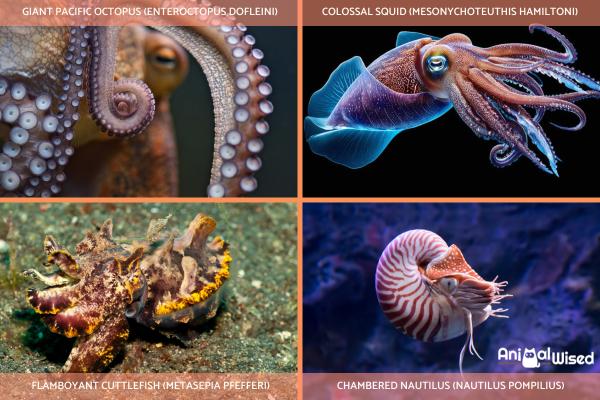
If you want to read similar articles to What Are Cephalopods? - Examples & Key Features, we recommend you visit our Wild animals category.
- Monterey Bay Aquarium. (2024). Cephalopods. Retrieved from https://www.montereybayaquarium.org/animals/animals-a-to-z/cephalopods
- National Oceanic and Atmospheric Administration (NOAA). (2024). California market squid. NOAA Fisheries. Retrieved from https://www.fisheries.noaa.gov/species/california-market-squid
- National Oceanic and Atmospheric Administration (NOAA). (2021). Cephalopod awareness days: Searching for nautilus in National Marine Sanctuary of American Samoa. Retrieved from https://sanctuaries.noaa.gov/news/oct20/cephalopod-days.html
- NOAA Office of Ocean Exploration and Research. (2019). Happy cephalopod week! Windows to the deep 2019. Retrieved from https://oceanexplorer.noaa.gov/okeanos/explorations/ex1903/logs/june28/june28.html
- Smithsonian National Museum of Natural History. (2024). Cephalopods: Octopus, squid, cuttlefish, and nautilus. Ocean Portal. Retrieved from https://ocean.si.edu/ocean-life/invertebrates/cephalopods
- National Wildlife Federation. (2023). Octopus. Educational resources wildlife guide. Retrieved from https://www.nwf.org/Educational-Resources/Wildlife-Guide/Invertebrates/Octopuses


